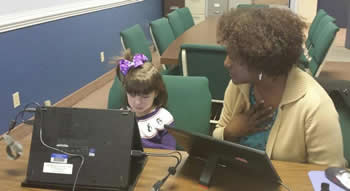 From the outset, the primary objectives of our work were to develop a psychometrically sound, highly portable, and developmentally scalable battery of EF tasks that were optimized for use with preschool-aged children. Further, we wanted a battery that could be administered in a variety of clinical or research settings by individuals who did not necessarily have experience with standardized testing or content knowledge of executive functions. These principles ensured that the battery would be widely applicable in a variety of settings, including for use in large scale field studies.
From the outset, the primary objectives of our work were to develop a psychometrically sound, highly portable, and developmentally scalable battery of EF tasks that were optimized for use with preschool-aged children. Further, we wanted a battery that could be administered in a variety of clinical or research settings by individuals who did not necessarily have experience with standardized testing or content knowledge of executive functions. These principles ensured that the battery would be widely applicable in a variety of settings, including for use in large scale field studies.
Our work has proceeded in four stages. The first stage, which was funded by the Eunice Shriver Kennedy National Institute of Child Health and Human Development (R01 HD051502; PI - Blair), involved the development of paper-and-pencil (flipbook) versions of multiple tasks that were intended to measure inhibitory control, working memory, and attention shifting. These tasks were largely adapted from tasks that existed in the literature. This initial stage of work involved extensive and iterative pilot testing and task modifications. The second stage of work involved administering the entire battery of tasks at the age 3-, 4-, and 5-year assessments in the Family Life Project (FLP). The FLP is a multi-site, population-based prospective longitudinal study of N=1292 children and their families (http://flp.fpg.unc.edu). The large sample size along with the extensive family and child assessments administered in the FLP facilitated multiple opportunities for us to test fundamental questions about the measurement and developmental course of EF in preschool-aged children (see the list of published studies). Despite the many contributions of these first two stages of work, it became clear that there were barriers to their more widespread use of the paper-and-pencil versions of our EF battery. Specifically, the requirement for two data collectors (one who administered tasks, the other who recorded child responses) and the use of third-party software complicated our ability to utilize the battery in other settings. The third stage of work involved computerizing the EF battery to overcome these limitations. An initial prototype of a computerized battery was completed using competitively awarded funds (R01 HD051502-06S1 ARRA; PI- Blair). Following this initial computerization, the battery was once again pilot tested and the individual tasks  were iteratively modified based on pilot experiences. The fourth and current stage of our work was funded by the Institute for Educational Sciences (R324A120033; PI - Willoughby). The objectives of the IES work include finalizing the content of the EF task battery (final task revisions, addition of new task), improving software installation and task scoring protocols, evaluating the retest reliability of the computerized battery, obtaining normative data on the battery (to facilitate norm-referenced scoring), and evaluating how performance on this battery compares to alternatives. In the process of this work, the battery was also translated into Chinese and Spanish. The IES funded work is intended to be finished by February 2016.
were iteratively modified based on pilot experiences. The fourth and current stage of our work was funded by the Institute for Educational Sciences (R324A120033; PI - Willoughby). The objectives of the IES work include finalizing the content of the EF task battery (final task revisions, addition of new task), improving software installation and task scoring protocols, evaluating the retest reliability of the computerized battery, obtaining normative data on the battery (to facilitate norm-referenced scoring), and evaluating how performance on this battery compares to alternatives. In the process of this work, the battery was also translated into Chinese and Spanish. The IES funded work is intended to be finished by February 2016.
